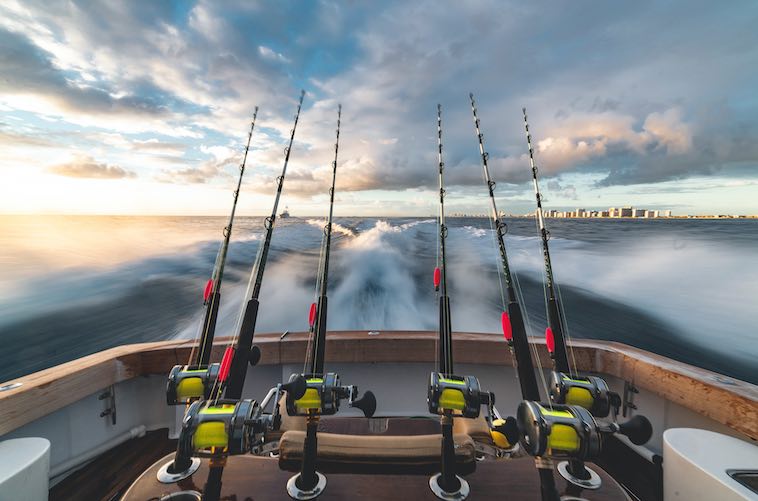

Fishing in the Gulf of Mexico
Fishing in the Gulf of Mexico should be on everyone's bucket list! The Gulf of Mexico is an angling mecca and for many, the ultimate location for the best fishing in the world.
The Gulf of Mexico is simply, full of fish and from these amazing waters brimming with sea life there is adventure and excitement for just about everyone. Whether it be inshore fishing, jetty or shore fishing or heading out in a charter boat to explore offshore fishing locations, the Gulf of Mexico has it all.
Around the Panama City/Panama City Beach areas there are many artificial reefs which add challenges and diversity for the fishing community.
Inshore fishing around Panama City
With a multitude of complex bay systems, brackish niches, and the beautiful emerald waters of the Gulf of Mexico lying just beyond, our backyard hosts a variety of marine life -- especially the tasty kind.
Some fish migrate upwards from the continental shelf as water cools, and some find their homes within the murky bays.
Regardless of where they might be or where they came from, Panama City presents some of the most distinguished in-shore fishing in the entire world.
After October and into mid-March, many species flock to the recedes of our bays to feed and seek protection from the winter waters of the gulf; a few of which being the Tripletail, Flounder, Sheepshead, and Redfish.
Tripletail


You'll definitely recognize a tripletail if you happen to come across one.
Why?
They are marked by their trademark triple tail! If you're lucky enough to hook one, you will never want a different fish for dinner.
These guys have a delicate white meat that flakes beautifully with a side of melted butter and a squeeze of lemon juice.
Tripletails regularly feed on small fish and crustaceans, but don't be fooled by their seemingly small diet; they can grow up to 35 inches and a whopping 41 pounds!
In order to attract their prey, they float to the surface and basically play dead so that their meal seeks cover under its body.
Flounder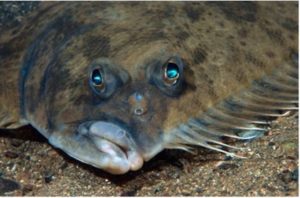

If you've never encountered a flounder before, their dirpy appearance will make you laugh.
With a flat white belly and a brown topside, these guys look like a steady cross between a stingray and a fish!
These guys tend to appear around wrecks and bay passes in late spring and early fall after spawning.
The catching difficulty varies depending on where you find them, but they are definitely one of the trickier fish to catch.
Spearfishing offers an adventurous alternative to their unique challenges they present to anglers.
Be wary, though; they are notorious for their excellent camouflage and might fool you!
As an aside, in South West Scotland there is a small village, Palnackie, which was home to the World Flounder Tramping Contest where the fish are caught by walking barefoot in the tidal water on an ebb tide and feeling for the fish lying on the muddy bottom.
The fish is then caught by hand!
Sheepshead
The name for these fish comes from their unique mammalian-looking face.
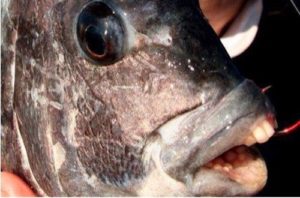

Their lips and teeth largely resemble that of an actual sheep!
These guys make for the perfect teacher to young anglers. Found along the rocks of the jetties, a short trip out to St. Andrews State Park will fill your cooler!
Easy to entice with only a shrimp, these guys will provide your family with not only a laugh, but adrenaline from the catch.
Redfish


Redfish are marked by the trademark dark brown spot (about the size of a dollar coin) on the upper portion of their scales right before the tail.
These guys are the chief of Panama City bay fishing.
They can grow up to over 2 feet long and weigh anywhere from 10-40 pounds.
The best part about these guys is that you don't even need a boat to get them! Smaller and medium-sized redfish are found in the shallow grassy areas close to shore, and the larger ones can be reached via kayak or paddle board.
They can be caught year round and can prove to be quite the fighter to even an experienced angler.
Offshore Fishing in the Gulf of Mexico
The Gulf of Mexico is composed of extraordinarily diverse ecosystems and gigantic, trophy-worthy fish.
These monstrous creatures can pose a challenge even to experienced fishermen and the journey offshore itself can be dangerous if the proper precautions are not taken.
Once out on the reefs and the continental shelf, however, the ride will have been worth it, we promise.
You'll find that it's quite ironic that the most colorful of fish come from the dark depths of the ocean.
Above all else, the angling feat will present a prize that is a sight for sore eyes!
The royal blue depths of the Gulf of Mexico are home to mahi mahi, red snapper, amberjack, and a variety of grouper.
Do not be fooled by their pleasing appearances; these guys will give you a run for your money.
Mahi Mahi
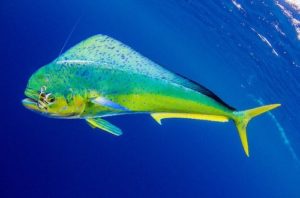

One of the most beautiful fish in the Gulf of Mexico, mahi (otherwise known simply as dolphin, though that can get confusing) usually resides 7 miles or more offshore in the depths of the gulf.
They are regulars of the surface too, as that is where they go to hunt -- and be caught!
Their prey consists of flying fish, crabs, and most importantly, squid.
This being said, because their diet is made up of moving animals, catching them requires trolling, sometimes for miles before you are able to spot a school.
However, you have not actually been to Panama City without getting your hands on some mahi mahi tacos, so our other promise here is that that reward makes the angling adventure a dream.
Red Snapper


By far one of the tastiest fish that mother nature has provided for us is the red snapper.
Bringing them up from the depths, sometimes from 620 feet, gives them a wonky appearance.
Sometimes the pressure makes their eyes bulge outwards and their stomach comes up to their mouth!
What adds to their deliciousness is the fact that the opening to catch them is so slim.
We always want what we can't have!
The best part is, the 2021 red snapper season is the longest it's ever been at 54 whole days.
Nothing tastes quite like a blackened snapper filet at one of our local restaurants; we really can't pick a favorite.
Amberjack


These guys share kingship of the Gulf of Mexico with the goliath grouper.
These monsters can grow up to 6 entire feet long and weigh 200 pounds.
Unfortunately, these guys have a strong, unpleasant flavor and are considered a game fish rather than a delicacy.Amberjack are also notorious for being riddled with long thin white worms which are in fact tapeworms. The fish need to be cooked thoroughly or frozen to kill off any worms.
Grouper
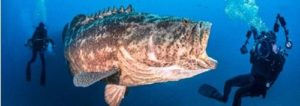

The most common of the groupers that you'll see are the gag grouper, the black grouper, the red grouper, and the absolute behemoth known as the goliath grouper.
They can be difficult to discern from one another, but don't worry, your captain will help you out.
No matter which kind you end up angling, getting them to the surface is an accomplishment within itself.
The goliath is the grouper of note, and you will know them when you see them, without a doubt.
They have been recorded to grow up to 8 feet and a whole 800 pounds; that weighs more than an American grizzly bear.
Do not fret, they are gentle giants that are aware of their size and will more than likely interact with you while diving to see if you have any snacks!
Florida Manatees
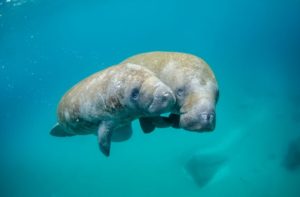

Yes, we know it is not a fish but every bit of publicity helps to protect these wonderful, gentle creatures.
Perhaps one of the cutest inhabitants of the Gulf of Mexico, the Florida manatee is a very threatened species, even though they have no natural predators.
Because of their size, relatively slow demeanor, and reliance on breathable air, they are often hit by moving vessels.
They are also very susceptible to colder weather, which has recently threatened them due to the weakening of the Gulf Stream.
As you can see from their appearance, they kind of resemble sea elephants.
In fact, they are more closely related to elephants than they are any other marine mammals! Like elephants, too, they also feel rather complex emotions like anger, fear, and joy.
Each pod or family also develops personalized calls that they use to communicate and identify each other.
Manatees are also smooth-brained. However, do not underestimate their thinking capabilities; researchers have found that they are sensitive to touch and can discern colors.
Like other mammals, female manatees are amazing mothers! They nurse their offspring for about 2 years and help them develop relationships with other members of their pod.
After reaching a certain age, manatees consume up to a tenth of their total body weight! That can be anywhere from 70-110 pounds of grass and algae.
Because 'red tide', a phenomenon characterized by an overgrowth of algae that produce toxins that can cause both aquatic and mammalian sickness, relies on warm waters, manatees are often killed during the early fall months when these algae are exponentially blooming.
If you happen to come across one of these gentle giants, please be respectful and help us protect our wildlife.
Red Tide
One of the major threats to fishing in the Gulf of Mexico is Red Tide.
Red Tide is an event which occurs along the coast line and is caused by algae blooms grow out of control. It is mainly caused by one species Karenia Brevis, which calls the Gulf of Mexico its home.
Red tides typically occur from late summer into fall when large blooms spawn 10-40 miles off shore and progressively invade the coast line causiung havoc to marine live, human life and the tourist industry.
In 2019, a major bloom killed nearly 150 dolphins and hundreds of tons of fish. About 400 sea turtles washed ashore and at least 100 manatees died.
What Causes Red Tide?
Although the blooms are thought to be largely due to Karenia Brevis, it is not known why they suddenly explode into uncontrolled growth. The actual cause of red tide remains a mystery.
The Red Tide Institute was established in 2018 with the mission of 'Reducing adverse impacts of Florida red tide on public health, coastal marine ecosystems and Florida's economy via the rigorous testing and application of a "tool box" of science-based mitigation and control technologies and strategies.'
Why are Red Tides Dangerous?
The algae that cause red tide emit powerful toxins which can kill mammals, fish, shellfish and birds.
People get sick from ingesting fish or shellfish which have been captured in algae infested waters.
During a red tide event, the shoreline is littered which dead marine life which have either succumbed to the deadly toxins or have died as a result of a lack of oxygen.
Red tide (apart from being very smelly), causes respiratory issues in humans and it is best to keep away from the beach when an event is in progress.
Local restaurants will remove any seafood from their menus if it has been caught in waters where red tide is present.
Red Tide in 2021
Red Tide Mid-Week Update for May 26, 2021
A patchy bloom of the red tide organism, Karenia brevis, persists in Southwest Florida, where it was detected in 57 samples over the past week. Bloom concentrations (>100,000 cells/liter) were observed in one sample from Manatee County, five samples from Lee County, and five samples from Collier County.
K. brevis was also observed at background concentrations in one sample from Northwest Florida. Additional details are provided below.
In Southwest Florida over the past week, K. brevis was observed at very low concentrations in Pinellas County (in one sample), background to low concentrations in Hillsborough County (in five samples), background to medium concentrations in Manatee County (in 15 samples), background to very low concentrations in Sarasota County (in 9 samples), very low and low concentrations in Charlotte County (in two samples), background to high concentrations in Lee County (in 17 samples), and low to high concentrations in Collier County (in eight samples).
Samples collected offshore of Monroe County did not contain red tide.
In Northwest Florida over the past week, K. brevis was observed at background concentrations in Escambia County.
Along the Florida East Coast over the past week, K. brevis was not observed.
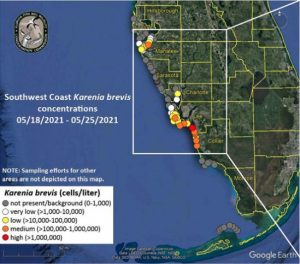

Not keen on fishing?
We have another page you might like -
Come and enjoy a jet ski dolphin tour with Freedom Watersports and explore our local waters, jet ski to Shell Island and swim with dolphins. You may also get to see turtles, manatees and sharks! We hope you have learned some useful things from our Fishing in the Gulf of Mexico blog post and have a great jet ski rental tour!
For more information about jet ski rentals please give us a call on:
850-481-0142
or book today online!
If you have concerns about the weather, please check out this link to give you the latest local conditions.

